Profiles in Excellence: College of Engineering alumnus Clint Crookshanks ’93 (mechanical engineering)
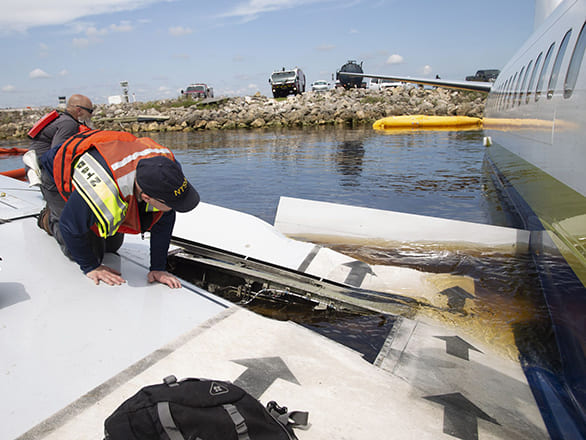
Clint Crookshanks
Clint Crookshanks '93 examining the landing gear attach point on a 737 that went off the end of the runway at NAS Jacksonville (Florida) and into the St. Johns River on May 3, 2019.
Through mechanical forensics, air crash investigator Clint Crookshanks unravels mysteries the world over—and in his own backyard.
When he was growing up, Carson City-native Clint Crookshanks ’93 (mechanical engineering) nurtured his love of aviation by attending the annual Reno Air Races. Little did he know that, on September 16, 2011, he would be in attendance as the future of the Races was suddenly and tragically called into question.
Third Time’s the Charm
Although he had offers to attend universities elsewhere, Crookshanks decided to stay in northern Nevada for his undergraduate education. After all, he had grown up going to Pack football games, spending time on campus, and watching pilots flash across the wide Nevada sky in daring displays of nerve and artistry.
Now, he recalls fondly his time in White Pine dorm, his term as Senator for the College of Engineering, and long hours working with classmates in a large conference room in Scrugham Engineering.
“We really helped each other out,” he said. “I loved it.”
After he finished his education at the University, on a whim, Crookshanks moved to Colorado and started waiting tables.
“It was a horrible time to be an engineer,” he said. “We were in an economic downturn, and we were all experiencing tough times financially.”
Soon enough, though, he found a job repairing and rebuilding airplane propellers and enjoyed “getting my hands dirty, figuring out how these propellers worked.”
The experience inspired Crookshanks to pursue his master’s in aerospace engineering sciences at UC Boulder. Upon completion of his degree, he was recruited to work for Boeing in Seattle. There, he spent a year in the dynamic flight loads group only to suffer yet another economic downturn.
“You realize early on that the aviation industry is cyclical,” he said. “Everybody I know in the industry has been laid off or threatened to be laid off. You just have to keep focused on the love of aviation. It’s going to come back. It always does.”
Crookshanks’ resilience led him to another job, back in Reno, building and installing 727 winglets. But one more time, the aviation industry hit another low point when the 9/11 attacks radically changed the way air travel was conducted. Once again, Crookshanks was on the hunt for a job. This time, he found his home as an Aerospace Engineer and air crash investigator at the National Transportation Safety Board.
“I never imagined I’d have this much fun in a job,” he said, “and no two crashes are the same. Each investigation is so unique and so different. Every time is a puzzle.”
As a structures engineering specialist, Crookshanks examines the airframe and the entire structure of the aircraft under investigation.
“What you’re looking for is evidence of failure or corrosion,” he said. “You methodically look at every piece, because humans may not tell the truth, but the metal doesn’t lie.”
The Go Team
Each year, there are approximately 1,300 aircraft accidents in the U.S and many more all over the world. Because the NTSB has a congressional mandate to investigate all U.S. accidents and will participate in the crash of any American made airplane anywhere in the world by international treaty, Crookshanks and his colleagues sit on a Go Team that has to be available 24/7.
“We can be sent anywhere in the world,” he said. “When we’re on call, we have a bag packed at all times.”
In the eighteen years he’s been at the NTSB, Crookshanks has worked numerous accidents in the United States as well as accidents in Indonesia, Ireland, France, Russia, Taiwan and China, and he was part of the investigation of the missing Malaysian Airlines Flight 370 in 2014. But two of his highest-profile investigations were here in the United States.
On February 1, 2003, a piece of foam insulation broke off the Space Shuttle Columbia, setting off a series of events that ended in the disintegration of the spacecraft as it re-entered the atmosphere. All seven crew members were killed. For five months, Crookshanks cataloged and examined all parts of the vessel that were recovered in Texas. Through meticulous investigation, his team was able to determine with physical evidence what led to the tragedy.
Reno Air Races crash
On September 16, 2011, Crookshanks and his colleagues were at the Reno Air Races when James K. “Jimmy” Leeward came around pylon 8; his aircraft, a modified P-51D Mustang named The Galloping Ghost, rolled left, then pitched up, and spiraled into the grandstands. The pilot died instantly, along with six spectators. In the coming days, another four attendees would die from injuries sustained in the crash.
“We were focused on The Galloping Ghost during the race,” Crookshanks said. “We saw the accident happen, and we immediately went from spectators to investigators.”
In a concentrated and expedited effort, Crookshanks and his colleagues began putting the pieces of the puzzle together. The airplane, under various names, had competed in air races all the way back to 1969, and Leeward himself had more than 30 years as a competitor.
“The age of the aircraft doesn’t mean much in itself,” Crookshanks said, explaining that if the vessel receives appropriate maintenance, it can continue to be airworthy indefinitely. But in the case of The Galloping Ghost, Crookshanks discovered, modifications to the plane ultimately led to its demise.
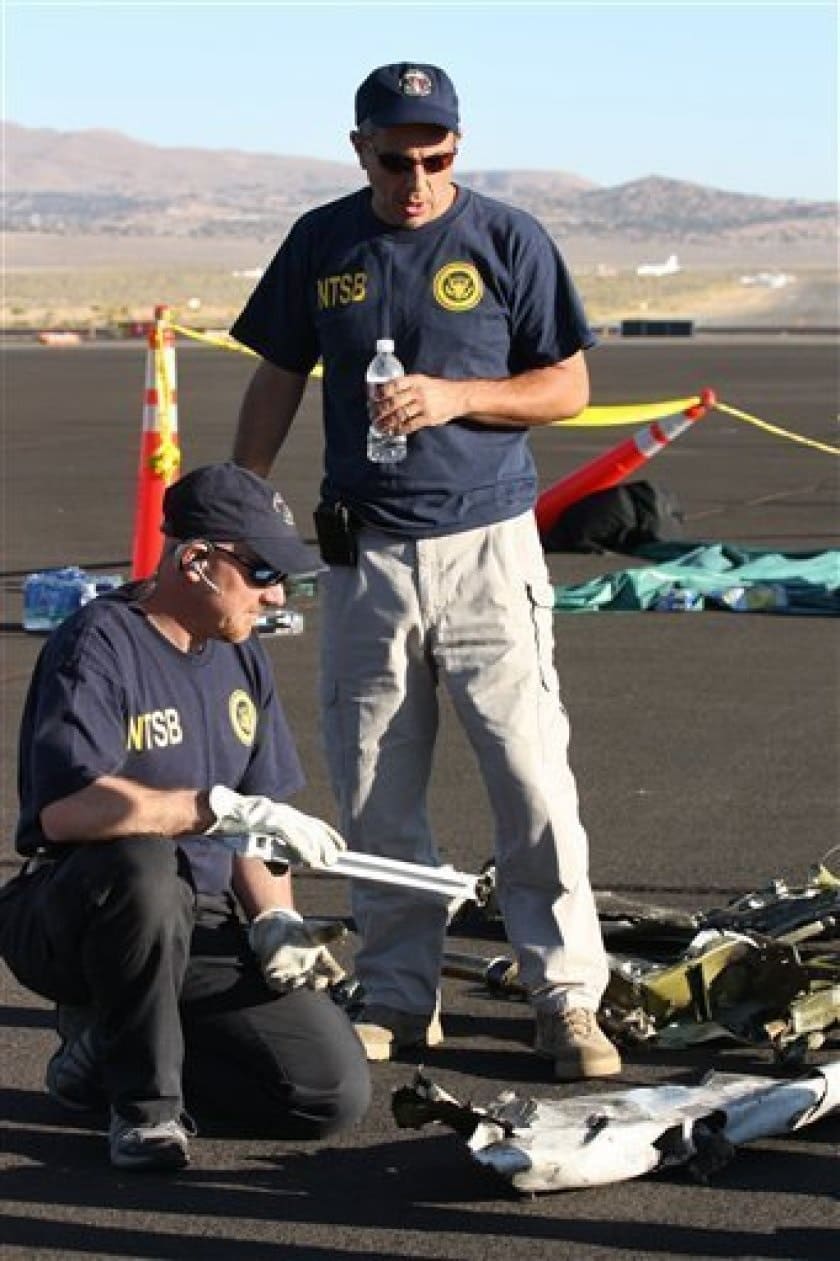
“The pilot had raced in Reno for 30 years, and he had never won,” Crookshanks said. “He saw the modifications other planes had undergone to increase speed, and he incorporated all of them on this airplane. No testing was done on the modifications, and he pushed the plane to its limit in the accident race. All those modifications came together and he had a flutter event that failed the left elevator trim tab. The plane rolled onto its back and into the crowd.”
To reach this conclusion, in addition to examining the physical evidence, Crookshanks went back to find the original details of the P-51D. He compared the specs to the state of the craft before the flight, identified each modification made, and analyzed what each would do separately and collectively.
During the investigation, the team made a series of recommendations to the Reno Air Races, including requiring engineering and flight testing of all modifications, providing high-g training to the pilots, redesigning the race course to soften the turns, and introducing safety features to protect the crowd. Although the NTSB has no authority to enforce its recommendations, the Reno Air Races took them and, one year after the accident, continued the longstanding Reno tradition.
“From the beginning, we wanted to make recommendations early enough to make sure they could be implemented before the 2012 races,” Crookshanks said. Nine years on, the Reno Air Races remain one of the signature events of northern Nevada, thanks to the work of Crookshanks and the NTSB.
Crookshanks said, “I love the Reno Air Races and what they do for aviation.”
Continuing a tradition of excellence through new aerospace program
To build on the tradition of excellence in aerospace engineering that pioneering alumni like Bill Rose have established, the Department of Mechanical Engineering is launching an aerospace engineering program that will offer a minor as well as undergraduate and graduate degrees. For those looking to follow in his footsteps, Crookshanks said, “An engineering degree teaches you how to solve a problem. It gives you the tools to methodically pursue an answer. An aerospace engineering degree is not an easy major, but there are a lot of rewarding jobs in the field.”
About the program itself, Crookshanks was exuberant: “It’s going to be awesome. I’m very excited that the University of Nevada will finally be offering an aerospace degree for students to follow their love of aviation”
ON THE JOB
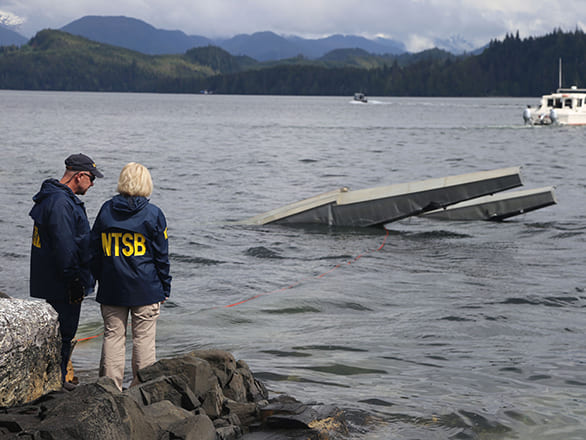
Crookshanks discusses with NTSB Board Member Jennifer Homendy the wreckage of a deHavilland DHC-2 Beaver that was involved in a mid-air collision near Ketchikan, Alaska on May 13, 2019.
.
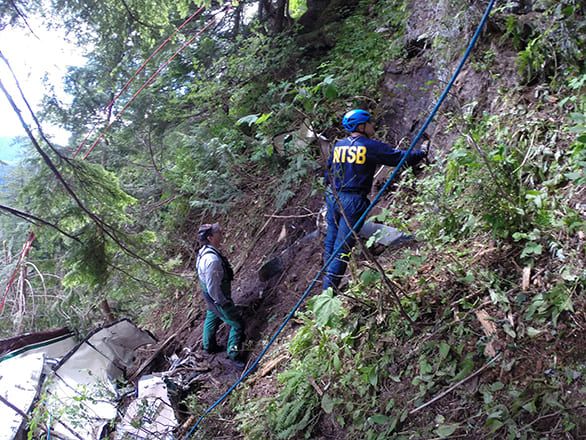
Crookshanks investigating the wreckage of a deHavilland DHC-3 Otter that impacted the side of a mountain near Ketchikan, Alaska on June 25, 2015.
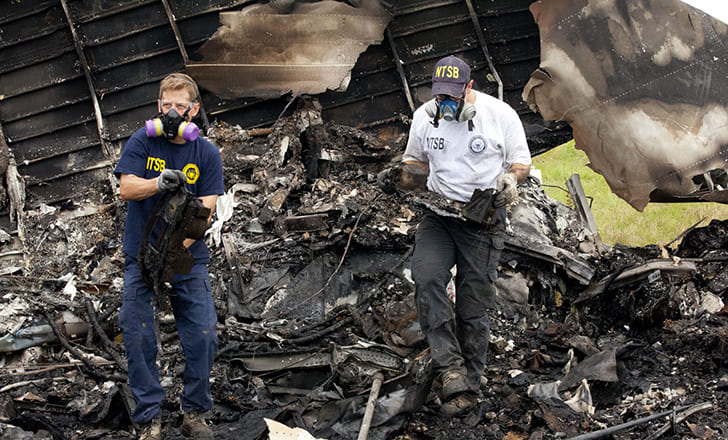
Steve Magladry (left) and Crookshanks retrieving the cockpit voice recorder (CVR) and flight data recorder (FDR) from the burned wreckage of a UPS Airbus A300 that crashed in Birmingham, Alabama on August 14, 2013.
Are you ready to make a world of difference?
Join the College of Engineering students, faculty and alumni who are developing the ideas, techniques and technologies that change the world.